5 Easy Ways To Reduce Kitchen Waste
I’m so excited to bring you today’s post! This has been a topic that has been on my mind a lot this past year, particularly since this job requires a lot of recipe testing, grocery shopping, brand and product shipments, etc.
Let me start off by saying that I’m not here to preach or advocate a zero waste lifestyle. I do not have one. Striving for perfection, in any area of your life, is impossible, overwhelming, and can often lead to inaction. This is particularly true, at least in my experience, when it comes to kitchen waste.
While reducing waste is incredibly important and does require a bit of a mindset shift, even the smallest changes can have huge impacts. Small efforts eventually lead to long-standing habits and lifestyle changes.
For some, that might mean investing in a travel mug (if you love your coffee shop visits!) or water bottle for travel. For others, that might be using reusable containers and packaging, in lieu of plastic wrap or Ziploc bags, a few extra times a month. This will look different for everyone.
My goal with this post is to simply share resources, helpful tips, and approachable ways that I’ve reduced my kitchen waste this past year. I hope you find it useful and inspiring!
This post contains affiliate links. If you purchase an item below, I may receive a small commission at no cost to you.
Stash Reusable Produce and Grocery Bags on Hand
I’ve been using reusable grocery bags for years and years, and am constantly amazed by how many people – particularly city dwellers – I see at the check out line without them. Although there are definitely times when I forget them, this is one of the easiest (and best) changes to add to your routine.
Reusable grocery bags are incredibly practical, as they hold significantly more items, can often be placed on your shoulder comfortably and have zero risk of breaking. They also come in handy for moves and other household chores.
In the past year or so, I’ve also invested in a set of reusable produce bags. These are another wonderful tool to cut down on soft plastic usage, but they don’t keep delicate produce nearly as well, so it’s best to prep, wash, and store those items separately after getting home.
Helpful Tip: Keep a small set wherever you are most likely to need them: car trunk, pantry/hallway, office, workout bag, purse, etc. I prefer the super thick sturdy ones, which are sold at places like Trader Joe’s and Whole Foods, as they’re very durable and can hold a lot, but there are many thinner options as well. It just depends on your preference!
Find Your Local Soft Plastic Recycling Center
The most substantial way that I’ve cut down on kitchen waste this past year is doing research on soft plastics. A little bit of research goes a long way. If you’re not sure how to recycle (or if you even can recycle) an item, look it up on the internet, contact your recycling service, or reach out to your favorite brand.
Basic plastics, such as food containers, milk jugs, or other plastic cartons are usually processed by your standard weekly recycling service (*be sure to look up your local recycling rules, as they vary!).
Recyclable soft plastics are items like garbage bags, newspaper bag coverings, product wrapping, shopping bags or dry cleaning bags, bubble wrap, deflated air pillow packaging, Ziploc bags, and the list goes on. These types of plastics require different processing than your basic hard plastic items. as they clog standard recycling systems and can easily contaminate large batches of recycling (resulting in them being dumped in a landfill). You can read more about this and other items you might be recycling wrong here. Educate those around you!
Many local big box stores (eg. large grocery chains, Target, Walgreens, etc.) are required to offer soft plastic recycling containers. You can search for your nearest plastic film recycling location here. We collect our soft plastic items in a reusable grocery bag and take them to our local Target every month or so – it’s an easy change that drastically cuts down our landfill waste!
Helpful Tips and Resources:
- Learn more about what’s recyclable and what’s not here.
- Set aside a large bag in a closet or pantry, save and fill it with any soft plastic items, and drop it off at your local soft plastic recycling location on a bi-weekly, monthly, or bi-monthly schedule. You can find your nearest plastic film recycling location here. Remember that these items need to be dry and unsoiled, but usually a quick rinse under the sink and dry session can fix this.
- Terra Cycle is another amazing resource, which offers many free recycling options through popular household brands (eg. Colgate, Clif, etc.), as well as paid recycling options (for practically every single item you can think of – silicone, baby food pouches, snack bar packaging, clothing, kitchen tools, etc.).
Invest in Reusable Silicone Bags and Containers
I’ve been using glass storage containers for a long time, but I’m the first to admit that grabbing an easy, disposable Ziploc bag for marinades, food storage, etc. can be tempting some days.
One common theme surrounding kitchen waste is convenience. Convenience is often accompanied by waste. It is tempting on most days. I totally get it. Reducing kitchen waste, at least in this day and age, does requires conscious effort and for you to sacrifice convenience. We all need to do our part, especially if we are in a privileged position to do so.
It is easy to make small changes on a regular, daily basis if you start slow and ease your way up. One specific goal of mine this past year was to invest in a few reusable silicone bags, eg. Stasher bags, in various sizes to reduce my use of Ziploc bags. We use them for travel, food storage (sandwiches, veggies, cheese, avocados, etc.), as well as prep (marinading meat for the grill, etc.).
If you do use a Ziploc bag, remember that they can be washed, dried, and reused multiple times, particularly if you’re using them for basic things like bread, nuts, produce, etc. Once they become unusable, they can be recycled with your soft plastic items (see above).
Helpful Hint: You don’t need to invest in a large set of expensive containers or bags to reduce kitchen waste; repurpose glass food jars, buy affordable mason jars, use covered mixing bowls or other dishes you already own for fridge storage, etc.
Use Bee’s Wrap in Lieu of Plastic Wrap
One of my favorite sustainable kitchen products is natural bee‘s wrap! It is a fantastic (and better) biodegradable alternative to plastic wrap, which is non-recyclable. Bee’s wrap is organic cotton that is dipped in melted beeswax. I came across this brand a few years ago when my mom bought me a pack, and have been a huge fan ever since.
You can buy them in sets or in specific sizes, and they work well for covering, wrapping and storing just about everything (with the exception of raw meat). They conform to the shape of your item with the heat of your hands. We use them for everything from bread storage, cheese, covering bowls, wrapping cut fruit, etc.
Best of all, they can be rewashed under cold water with soap, dried, and reused for up to a year or longer! Having a set of these on hand (along with a few reusable storage bags or containers above) will drastically reduce your plastic wrap usage.
Another great way to eliminate plastic wrap? Stop buying it. Out of sight, out of mind, Again, one of the biggest roadblocks to reducing kitchen waste can be pure convenience (and just having the option at your fingertips). Once you don’t have it on hand – and have a few other options at your disposal – you won’t think about it.
Helpful Hint: Trader Joe’s sells a generic version of beeswax wraps, but I have tested those and find them way too thick to work effectively. I highly recommend the original bee’s wrap brand, which is a much thinner and better option! If you’re feeling ambitious, you can even make your own.
Replace Paper Towels with Cloths
Another big change that I’ve made with my kitchen routine over the past two years is to (almost completely) eliminate paper towel use by investing in a set of basic microfiber cloths.
This is another easy way to reduce kitchen waste. You’ll also save a lot of money on paper towels! We use cloths for wiping down countertops, appliances, cleaning spills off the floor, etc. and keep a container of them under the kitchen sink for easy grabbing. Unlike paper towels, you can also easily give them a rinse too.
While I do keep a roll or two of paper towels on hand (for the rare, particularly disgusting, household or pet cleaning task), I rarely, if ever, use them. The trick is to get a large enough set (18-24) so that you never run out between laundry loads. We set aside some for kitchen cleaning, and others for bathroom, household cleaning, etc.
Helpful Tip: Microfibers can be fairly static by nature, so keep this in mind when doing laundry. If they develop any sort of off smell, add baking soda or basic white vinegar to your washing load. It almost always takes care of it!
Other Significant Ways to Reduce Kitchen Waste:
- research home or local composting options or pick-up services
- even if you don’t have outdoor space, there are usually pick-up compost alternatives in most cities. The majority of kitchen trash is made up of compostable items, such as a food scraps, compostable fibers, etc. I’m actively looking into investing in this service this year and will keep you posted about it!

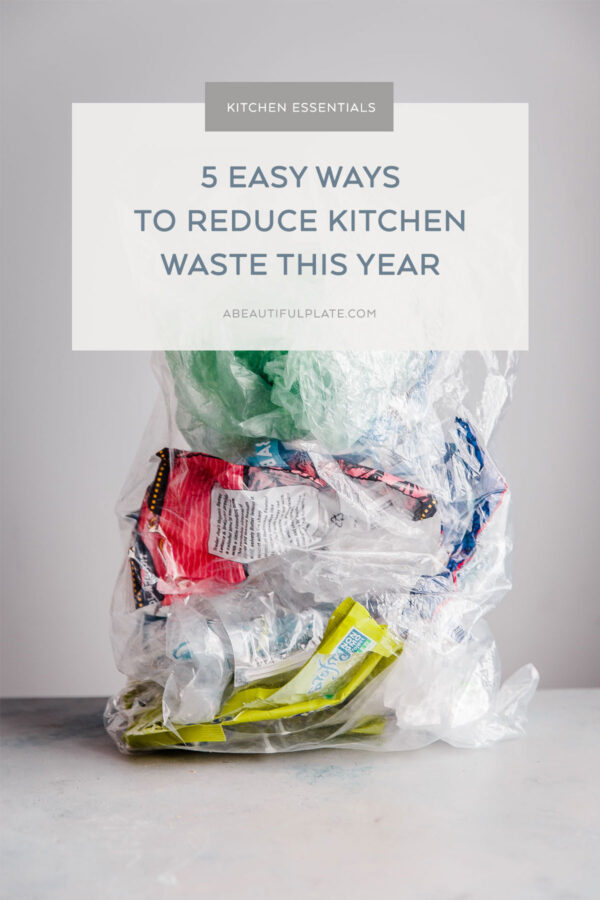
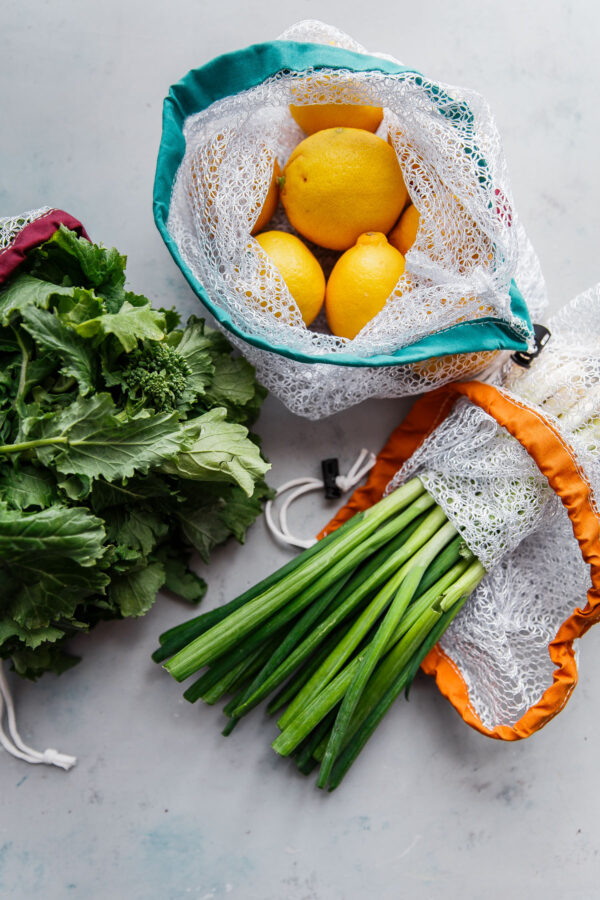
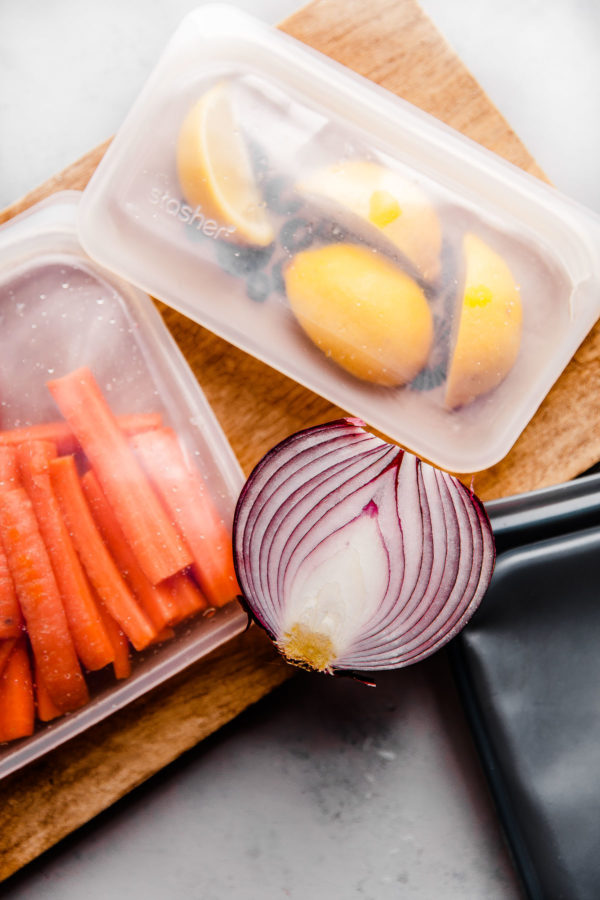
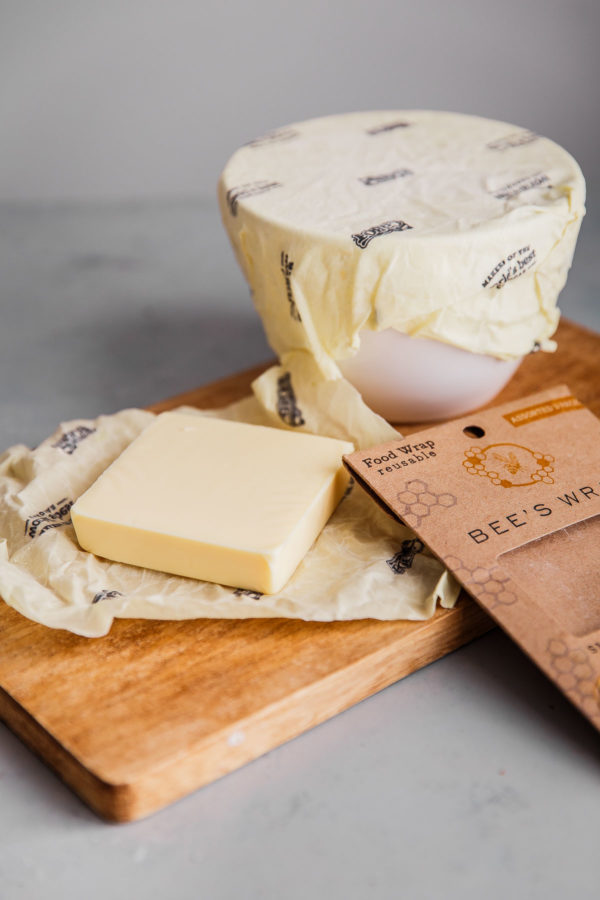
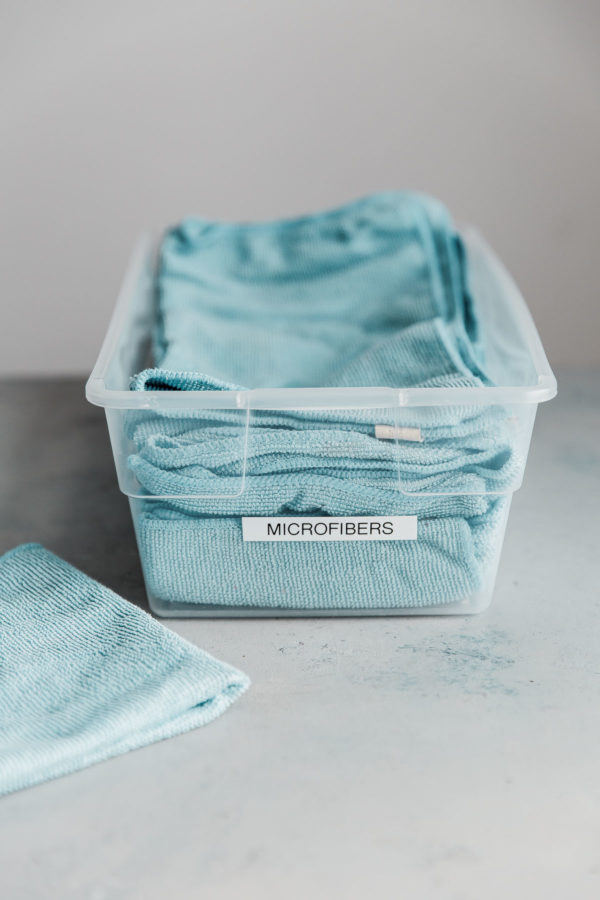
17 Comments on “5 Easy Ways To Reduce Kitchen Waste”
Thank you for your informative article. I am always trying to reduce waste. I just purchased a roll of NatureZway perforated towels which are made from bamboo. They are reusable and washable “up to 100 times or more” according to the company. I haven’t used them long enough to test that claim, but I was happy to find an alternative to paper towels. I like the idea of using microfiber towels as well.
I think I’ve heard of those! Another great suggestion! 🙂
I absolutely love all your tips on saving waste in the kitchen and saving the planet. I have been doing most of this for a long time. It hurts to see so much waste now that almost everything is disposable. Like you said, it’s convenient, but so much waste. Not acceptable in my opinion. Thank you for making people aware!!!
This is a fabulous article with some great tips and suggestions. I immediately bought some of these products. I already use glass and reusable plastic containers and try to use silicone lids when placing items in bowls for the freezer rather than plastic wrap. Placing the plastic wrap etc in the dining room has helped me reach for alternative “green” items first! Love the websites recommended as well! Thank you!
What a very helpful post! I used to use microfiber cloth in my kitchen but it always smells after a short while so I returned to paper towels. Thanks for the baking soda/vinegar tip, and I guess you’re right about having lots of them! I always ran out of supply in betwern washings.
Yes! I’ve found they can smell after a while, but the vinegar and baking soda (be generous with both; I add vinegar to my prewash) completely takes care of it!
Hi Trish, have you heard of Norwex? They are awesome microfiber cloths that have a natural antibacterial agent that does not allow bacteria to grow, therefore, not smelling. They are amazing. I am a distributor for them if you are interested in more info., let me know!
Pingback: Friday Faves | foodiecrush
Thank you for writing about the topic of recycling on you blog. Like you, for years I have been using reusable bags at the grocery store as well as all other retailers. As you say, once you make it a habit, it comes naturally to have your reusable bag ready. Let’s all do our part to save our planet for the next generation!
Good to know about the TJ’s wax wrap, I’ve been wanting to try it! I will probably grab the original version instead. I’d love an update if you find a good composting option in Chicago!!
I’m actively researching options now! I’m leaning heavily towards Waste Not Compost (https://www.wastenotcompost.com), because their prices are competitive and they use zero-emission vehicles for pick up. Other options out there are: Collective Resource, Healthy Soil Compost, and The Urban Canopy. I know that some farmer’s markets also have compost drop off’s, but that can be more challenging and hard in the winter months.
Here’s a great resource site with all of the links and information: https://www.zerowastechicago.org/compost/pick-up
I’m bummed that the Trader Joe’s stuff doesn’t work as well, but it’s so thick! I can’t get it conform easily to anything, and just don’t think the cost savings are worth it compared to how much better the real stuff is. Glad this post was helpful and so thrilled to hear that you might consider composting too!! It’s something I’m really excited to start doing.
Thanks! Composting was so easy when we lived in upstate NY. We had a neighborhood community garden down the street, and we could just dump our under the sink compost bucket once a week there while we were out walking the dog.
One way that I tried to reduce waste was to save all my veggie scraps in the freezer and make broth out of them, but it did NOT taste good! 🙁
Yeah, I think it depends on the veggie scraps 🙁 They would probably work better for chicken broth, etc. if you eat meat. So jealous of your community garden! I wish we had accessible options like that our fingertips here. It’s sad that it isn’t a required and regular part of trash removal.
Thank you for this great post! I love your ideas. Reducing waste in general has been one of my resolutions this year. I’m excited to try the Bees wax product as an alternative to plastic wrap. Thanks again!
I’m so glad to hear that it was helpful Amber! And good for you on your resolution, any small changes really add up and they become much easier to implement as you keep doing them.
I LOVE Bee’s Wrap. It always feels so decadent using it. Stash is best in class for storage, too!
And I have about 3 dozen great kitchen towels in rotation — after they are wet from drying dishes, we use them as we spray & wipe down counters. It is way more efficient and kinda makes you wonder how paper towels ever came into fashion.
I also have been making my own linen drawstring produce bags – I couldn’t shake the weird feeling of loading a bunch of junky wasteful plastic produce bags into my REUSABLE shopping bag. I have listed these in my shop as well (which always feels like an annoying plug – but there you go). If you find a nice linen or cotton version, they are so great for storing produce as they will wick excess moisture and let things breathe (versus that sticky, foggy, wet interior of a plastic produce bag in the back of your fridge).
I love Bee’s wrap too! It does feel decadent – I really look forward to pulling it out to use! Totally get it. I wish paper towels had never come into fashion either.
Also, thanks for sharing your store! Your produce bags look beautiful. Your right that I definitely need to get some linen/cotton versions, because those would work so much better than the mesh ones for some types of items. Thanks Julie!